
stellar lifetimeyears = 1010 masssolar / luminositysolarSince luminosity is approximately equal to mass3.5 (in solar units), this is equivalent to
stellar lifetimeyears = 1010 / masssolar2.5leading us to the conclusion that more massive stars burn out more quickly.
We will continue to use the common term "burning" for the nuclear reactions which power stars. But it is important to understand that stars are not "on fire": there is no organic material to be oxidized, and not much Oxygen to do the oxidation.These graphs illustrate the lifetimes of stars of 0.5, 1, 1.5, 3, 5 and 9 solar masses, from various perspectives (use the Shift key to expand them):
What happens next is a tug of war between the opposing pressures due to fusion and gravity: as fusion products build up in the core, its density increases. The core shrinks, the pressure increases, the temperature increases, heavier nuclei begin to fuse in the core and previous fusion reactions move outward into shells. As the fusion reactions take place in regions closer to the surface of the star, the outward pressure from those reactions enlarge the star. Depending on the size of the star, this process can repeat, with multiple shells supporting different reactions simultaneously.

The fusion of successively heavier nuclei is an accelerating process, due to the drop in the number of nuclei available to fuse. Carbon fusion might last for hundreds of years before Oxygen fusion begins, but Oxygen burning might last only a year or so before Silicon fusion begins. It takes about a day for the core to fuse into Iron.
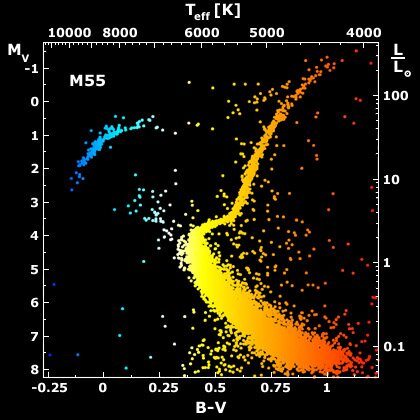
Since more massive stars have shorter lives, the "end" of the main sequence tells us how old the cluster is. Compare visible and ultraviolet images of the cluster Omega Centauri; note the obvious population differences between hot and cooler stars:

Numerical values in this section are approximate. Stellar life cycles are based on models described in 1965 and 1967 by Iben (Astrophysical Journal 141:993 and Annual Reviews of Astronomy and Astrophysics 5:571, respectively).
Note the shapes of the nebulae in these images; the processes which create them must be far less symmetrical than the naive spherical stellar model which all our discussion of radii imply:
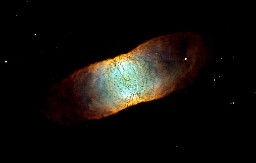 | IC 4406; probably cylindrical, seen from the side (R, G, B = Nitrogen, Hydrogen, Oxygen). | source |
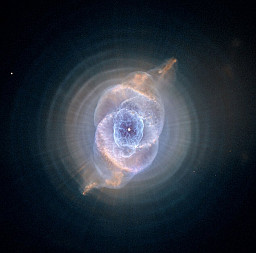 | NGC 6543: The Cat's Eye Nebula. | source |
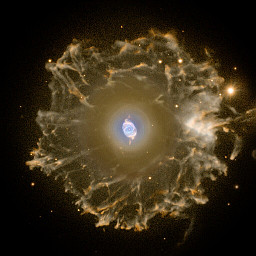 | The extended halo of the Cat's Eye Nebula. | source |
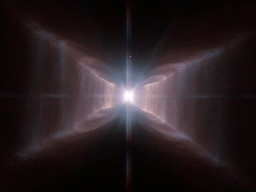 | HD 44179 appears to be a binary system nearing the end of its life. | source |
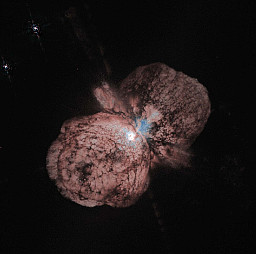 | Eta Carinae, shedding mass. | source |
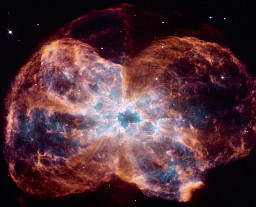 | NGC 2440 (R, blue-green, B = Nitrogen/Hydrogen, Oxygen, Helium). | source |
A white dwarf is a degenerate star because its atoms are as close as possible within the constraints of the Pauli Exclusion Principle, which tells us that no two electrons can be in the same state. In this condition, every atom is in the lowest state possible, so that the number of available states, or degeneracy, is as low as possible.
Sirius B is a white dwarf whose absolute magnitude is 11.2 and whose mass is approximately equal to that of our Sun. Its luminosity is then
L = 10(4.83 - M)/2.5Its black body temperature is around 14,800 K, so its radius is= 10-2.548 = 0.0028 Lsolar
r = (L / (4 π σ T4))1/2From this we can compute its average density= (0.0028 * 3.84 * 1026 / (4 π σ 148004))1/2= 5.61 * 106 m = 0.008 Rsolar
ρ = m / (4/3 π r3)and its escape velocity= 2 * 1030 / (4/3 π (5.61 * 106)3), times 0.001 to convert kg/m3 to g/cm3,= 2.7 * 106 g / cm3 (!)
escape velocity = (2 * G * mass / radius)1/2Its surface gravity is= (2 * G * 2 * 1030 / 5.61 * 106)1/2= 6.88 * 106 m/s
= 0.023 c.
surface gravity = G * mass / radius2which means that if you could survive on its surface, you would weight about 430 thousand times as much as you do on Earth! These values are typical orders of magnitude for white dwarfs:= G * 2 * 1030 / (5.61 * 106)2= 4.22 * 106 m / s2,
| White Dwarf | Absolute Magnitude | Masssolar | Radiussolar |
|---|---|---|---|
| 40 Eridani B | 11 | 0.501 | 0.0136 |
| Procyon B | 13.2 | 0.604 | 0.0096 |
| Sirius B | 11.2 | 1 | 0.0084 |
(source)
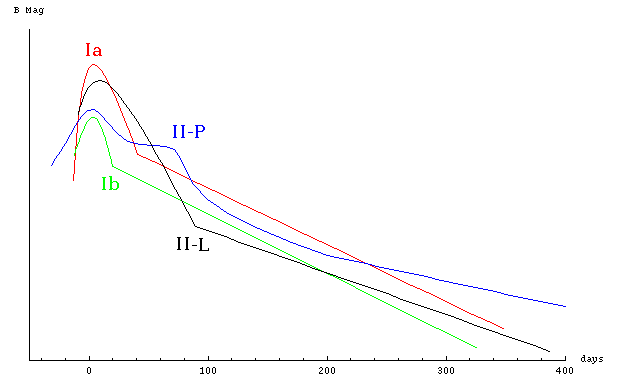
If the final mass at core collapse (after the shells have been shed) is less than 3-3.2* solar masses, the remnant will be a neutron star. In a neutron star, the atoms have come so close to each other that the electrons have been absorbed into the nuclei, releasing neutrinos. The remaining neutrons are now degenerate: they are as close as possible within the constraints of the Pauli Exclusion Principle. A neutron star is essentially one large, extremely dense nucleus, with no net electric charge.
*Most neutron star masses are close to 1.4 Msolar; the largest measured so far is about 2.1 Msolar. The actual limit depends on how neutron matter behaves, and is the subject of ongoing research.If the neutron star is rotating, and has a sufficiently large magnetic field whose axis is not along the rotation axis, we may observe it as a pulsar. It is assumed that most if not all stars rotate, so by conservation of angular momentum, a collapsed core such as a white dwarf or neutron star will rotate much faster than its progenitor, by a factor of
(r before / r after)2.The neutron star at the heart of the Crab Nebula has about 1.4 times the mass of Sirius B but its radius is only about 10 kilometers. This is 560 times smaller, so its density is 250 million times larger, its escape velocity is 28 times larger (0.64 c) and its surface gravity is 440 thousand times greater! We have already seen the Crab Nebula in multiple wavelengths; here is an x-ray image of the neutron star and supernova remnant Cassiopeia A:
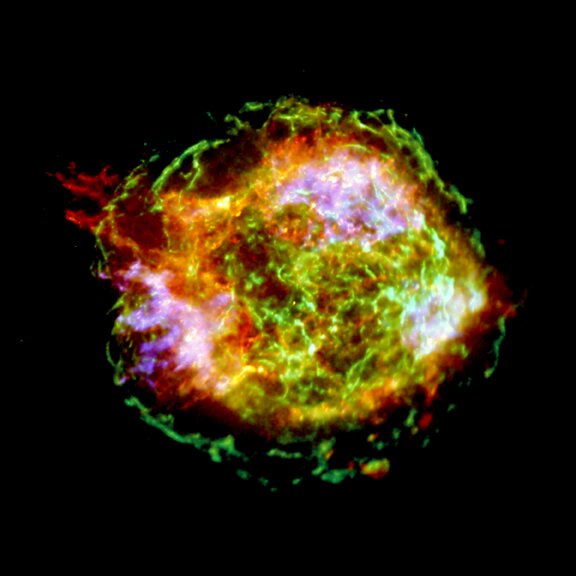
Planetary nebulas glow from irradiation by the remnant white dwarf or neutron star.
Now consider our old friend Betelgeuse. As we mentioned in previously, it is an M2Ib star located 427.3 light years from us. Its temperature is about 4000 K, its mass is about 20 Msolar and its luminosity is about 50,000 Lsolar. That means that its radius is
r = (50000 * 3.84 *1026 / (4 π σ 40004))1/2Since its luminosity is varying, we know it is in the horizontal branch, and it is estimated that within 10,000 years it will explode as a supernova. Assuming the supernova has a peak luminosity of 1010 Lsolar, the energy flux we should experience here on Earth is= 3.25 * 1011 m = 464 Rsolar
energy flux = luminosity / (4 π distance2)This may not seem like much compared to the total flux we receive from the Sun, but consider that much of this is in gamma radiation. If we assume the normal gamma flux is 5 MeV/cm2/s, or around 8 * 10-9 W/m2, this is a lot of radiation. The lesson here is that the neighborhood affected by a supernova is very large. In any given galaxy, every 30 to 50 years another star explodes as a supernova:= 1010 * 3.84 *1026 W / (4 π (427.3 ly * 9.461 * 1015 m/ly)2)= 0.0187 W/m2
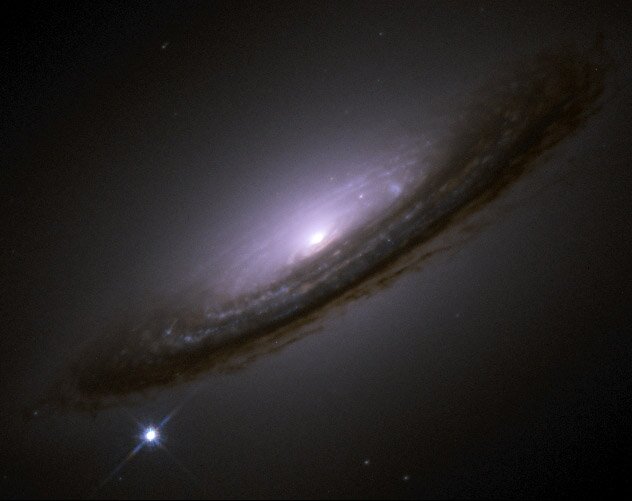
This makes the universe seem like a violent place, and it can be. But it is important to remember that the explosion of a supernova not only disrupts its neighborhood, but it also seeds the interstellar medium with heavier elements, and the shock waves compress that medium so that more stars can develop in the future:
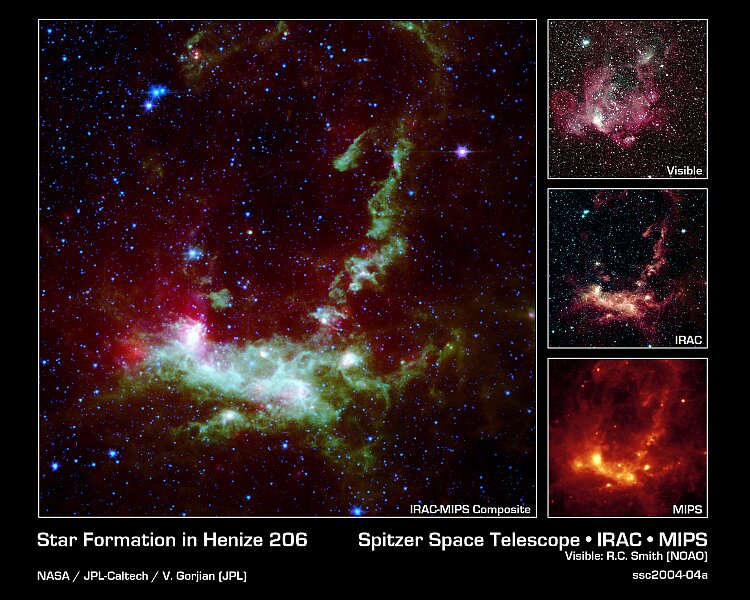
Star forming regions in galaxies are identified by the hydrogen gas glowing in infrared and by the ultraviolet light of young, bright stars.
©2010, Kenneth R. Koehler. All Rights Reserved. This document may be freely reproduced provided that this copyright notice is included.
Please send comments or suggestions to the author.